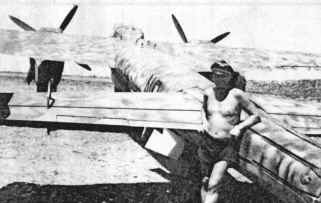The
Dornier Do-217M
bomber was the type which an improved version of nightfighter Do-217N was developed from
. The first Do-217N´s were assigned to
combat units (Nachtjagdgeschwader)
of the Luftwaffe at the end of 1942
and in the beginning of 1943. In spring 1943 a double seat version Do-217N-2
began being produced.
The N-2´s had better
aerodynamical characteristics and they had all flexible guns removed.
Just during production more effective
cannons MG-151/20 were installed instead older MG FF cannons. The version
Do-217N-2/R22 with uncommon equipment which is being described in this article had also
four more MG-151/20´s installed. They found themselves in the bottom
of fuselage. This version was also equipped with Schräge
Musik on the top of fuselage. About 200 planes of the Do-217N version
were completed by the end of 1943.
Some
pre-production planes and some planes of the production line of
versions E-0 and E-2 as well were equipped with
braking
shields at the rear of the fuselage. These brakes were able to slow down the
speed of the plane during nosedive fly. Aircraft of the E-2 version being equipped with
the brake appeared in combat for the first time at Stabstaffel
StG.2. However, the aerodynamic brake did not work reliably. When it was
opened it caused strong flutters of the fuselage. It also happened that a pilot
could not close the opened brake and he had to shooted it down to
avoid the destruction of a plane. Because of above described problems the Technisches
Amt have decided to cancel development of the Do-217 in nosediving bomber
version since summer 1941.

As the photo above shows tests of the aerodynamic brake were also done on a Do-217N-2/R22. A parachute which was set in a tail case was fixed in its corners on eight rods. The rods were turned out in an expected moment during the flight, parachute ropes were pulling out at the same time as well and the parachute was pulled out from the case.
For modellers who are longing for having of this aircraft in their
collection in 72nd scale there is only one possibility. It is conversion of the ITALERI Dornier Do-217N-1 kit with using a conversion set by
A+V MODELS firm. This Czech firm offers a conversion set for the N-2 version.
However, we have to continue with improvising.
It means we will have to handmake a case for the parachute because there is
not any company in the world which
produces this one. It is a pity because the Do-217N-2/R22 is surely
a very exciting warbird for all who are interested in night fighters of
the Luftwaffe.
Dornier Do-217N-2/R22 equipped with the parachute brake was tested at Boyuritche air base in Sofia, Bulgaria in 1943. The plane might belonged to NNJ Schwarm (according to the code + NO). The unit was subordinated directly to Luftwaffe Kommando Ost. There were usually operating four Messerschmitt Bf-110G-2 nightfighters in this special unit which was established in November 1942 on the basis 12.Staffel ZG.1. The ZG.1 planes wore codes 8V. However, this code is missing on the fuselage of the plane. NNJ Schwarm was reorganized in August 1943 and converted to 4. and 8. Staffel NJG.200 which a/c had the same codes. There was one more unit in NJG.200 - 5.Staffel which a/c wore probably codes 6V.
The plane wore one of camouflage schemes which was used to apply for twin engine nightfighters. All surfaces were sprayed RLM 76 Lichtblau shade and then oversprayed with "snakes" of RLM 75 Hellgrau on upper surfaces and fuselage sides. The national insignia was done in a simply form only in white on the fuselage and upper wings, on lower surfaces of the wing were Balkenkreuz type crosses. Swastika on fins is in black with white and black outline. Spinners and propeller blades are in RLM 70 Schwartzgrün.